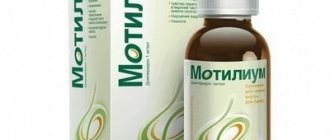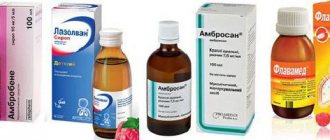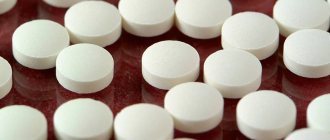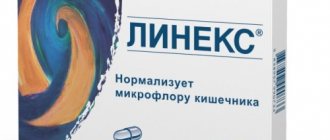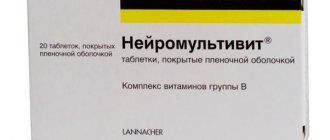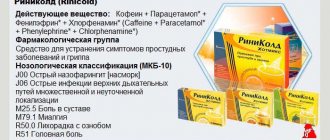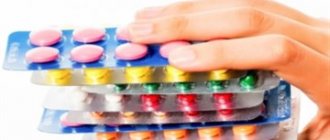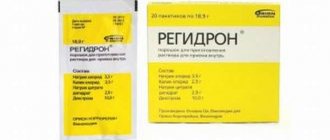Composition and release form
The drug Motilium has four formulations, but in all of them the active ingredient is domperidone. The drug does not have any other active ingredients, but there are auxiliary ingredients, the set of which depends on the release form of Motilium:
- Tablets to swallow are biconvex, white or beige in color, and the sides of the tablets are engraved with “Janssen” and “M/10.” It also contains lactose, hypromelose, microcrystalline cellulose, magnesium stearate, hydrogenated vegetable oil, sodium lauryl sulfate, polyvidone, corn and potato starch.
- Lozenges are white, matte, round in shape. They additionally contain mannitol, aspartame, gelatin, poloxamer 188 and mint essence.
- Suspension for children (also called syrup for children) is a liquid in a special bottle. In addition to domperidone, it contains sodium hydroxide and saccharinate, methyl parahydroxybenzoate, carboxymethylcellulose and the drug is based on water.
It is better to select the form of Motilium depending on the reason for prescribing the medicine and the age of the person (in a child, tablets can further cause a gag reflex, and in syrup it is convenient to use the drug at any age).
Activity in the body
The drug Motilium acts as an antiemetic and relieves nausea and heaviness in the stomach due to its component composition, or rather domperidone. It helps cleanse the stomach and close the sphincter valve so that food is not thrown back into the esophagus and does not provoke heartburn and other unpleasant sensations.
The maximum concentration of the drug in the body is reached 1-1.5 hours after administration , and is completely eliminated after 7-9 hours. But such a good concentration will occur in a short period of time if you take the medicine correctly - before meals, otherwise the absorption of the drug will be reduced.
Regarding the withdrawal time of Motilium, everything is very individual, if a person has problems with kidney and liver functions.
Therapeutic effect
Motilium has the ability to eliminate nausea, stop vomiting, and gently activate intestinal motility. The active component of the drug, domperidone, exhibits some properties of an antipsychotic, suppressing sensitivity to dopamine. Unlike other inhibitors, it is more neutral: it does not cause dystonia, tremor, or nervous tics.
The drug increases the tone of muscle fibers and enhances contractions of the esophageal sphincter in its lower part. Thanks to this, the evacuation function of the stomach is normalized, signs of dyspepsia, indigestion, and other motility disorders and diseases of the gastrointestinal tract are eliminated.
The drug is absorbed by the mucous membranes within a few minutes and actively binds to blood proteins. Transformed by liver cells. It is excreted from the body by the kidneys and with intestinal contents within 0.5–1 days after administration.
Domperidone stimulates the release of prolactin. The secretion of gastric juice and its acidity are not affected. When consumed during or immediately after a meal, the effect of Motilium may slow down somewhat.
Indications for use
The use of the drug Motilium should be carried out according to the instructions, which spell out what the drug helps with.
Most often, Motilium is prescribed to adults and children for:
- Nausea and vomiting.
- Motion sickness while traveling.
- Reflux esophagitis.
- Cholecystitis.
- Heartburn and belching.
- Baby burping.
- Peptic ulcers of the intestines.
- Hypotension or atony of the stomach and intestines.
- Hiccup.
- Cholangitis.
- Flatulence and bloating.
- Biliary dyskinesia.
- Pain in the stomach caused by vomiting or malfunction of the organ itself.
Advertising of the drug:
This is what Motilium cures. But you can also drink it to speed up the digestion process. Motilium is also used in complex treatment to eliminate stomach and duodenal ulcers, but here the prescription must be carried out by a doctor.
Drug interactions
The bioavailability of Motilium taken orally is reduced in the case of previous intake of sodium bicarbonate or cimetidine.
At the same time, you should not take antisecretory and antacid medications, because they reduce the bioavailability of domperidone.
Anticholinergic drugs can neutralize the effect of Motilium.
Medicines that significantly inhibit the CYP3A4 isoenzyme may increase plasma concentrations of domperidone. These include azole antifungals (ketoconazole*, itraconazole, voriconazole*, fluconazole*), macrolide antibiotics (eg, erythromycin*, clarithromycin*), HIV protease inhibitors (eg, indinavir, fosamprenavir, nelfinavir, atazanavir, ritonavir, amprenavir, saquinavir). ), calcium antagonists (verapamil, diltiazem), amiodarone*, nefazodone, aprepitant, telithromycin. Drugs marked with an asterisk (*) also prolong the QTc interval.
Motilium has gastrokinetic properties, so it is assumed that it may affect the absorption of concomitantly administered oral drugs, in particular enteric-coated and sustained-release agents. However, taking domperidone by patients while taking digoxin or paracetamol did not affect the blood levels of these drugs.
If necessary, Motilium can be used simultaneously with antipsychotic drugs (it does not enhance their effect), as well as with dopamine receptor agonists (levodopa or bromocriptine) - domperidone suppresses their peripheral effects (nausea, vomiting, digestive disorders), but does not affect the central action.
Instructions for use
The description of the drug contains instructions on how it is used and all people are strongly advised to use the drug exclusively in accordance with these instructions. But if the doctor prescribes Motilium with a different course or dosage, then you must follow his instructions. Let's look at how to take the drug in general cases, depending on the pathology:
- For vomiting and nausea Motilium helps if you take it in 20 ml syrup or 2 tablets. Should I do this before or after meals? - definitely up to, three times a day, and also at night. Children are given a suspension based on their body weight (5 ml of Motilium per 10 kg). The number of applications and time are the same. The daily dosage of the drug should not exceed 80 mg (for tablets and syrup) and 2.4 mg/kg (for suspension).
- For heartburn, chronic dyspepsia, bloating Motilium is given in tablets of 10 mg three times a day on an empty stomach. Another tablet can be taken before bedtime as needed. But only adults are given tablets; liquid Motilium is more suitable for children. Its dosage is 2.5 ml per 10 kg of child’s weight, drink three times a day before meals. The daily dosage, as in the first case, should not exceed the indicated units.
You should always find out more about the drug and its dosage methods in various cases from your doctor, since self-administration of the medication can cause negative side effects.
Motilium
Motilium ®
(lat.
Motilium
®) is a second generation prokinetic agent intended for the treatment of diseases of the upper digestive tract, accompanied by a decrease in motor-evacuation function, as well as an antiemetic drug.
Dosage forms of Motilium:
- lozenges
- film-coated tablets
- suspension for oral administration
Active substance:
domperidone. One lozenge or film-coated tablet contains 10 mg of domperidone. The oral suspension contains 1 mg of domperidone per 1 ml.
Excipients:
- lozenges - gelatin, aspartame, mannitol, mint essence, polyxamer 188
- film-coated tablets - lactose, pre-gelatinized potato starch, corn starch, hydrogenated vegetable oil, microcrystalline cellulose, magnesium stearate, polyvidone, hypromelose, sodium lauryl sulfate
- oral suspension - sodium saccharinate, sorbitol, microcrystalline cellulose, sodium carboxymethylcellulose, methyl parahydroxybenzoate, propyl parahydroxybenzoate, sodium hydroxide, polysorbate, purified water
Appearance:
- lozenges - white or almost white round tablets
- film-coated tablets - round, biconvex, white to pale cream in color, labeled "Janssen"
- oral suspension - homogeneous white suspension
Pharmacotherapeutic group
- antiemetic, central dopamine receptor blocker. According to the pharmacological index, motilium belongs to the group “Gastrointestinal motility stimulants, including emetics.” For ATC - to the group “Gastrointestinal motility stimulants”, code A03FA03.
Motilium blocks dopamine D2 receptors and thus eliminates dopamine inhibition of the motor activity of the digestive system. Increases the duration of gastric antrum and duodenal peristalsis, prevents slow gastric emptying, and increases the tone of the lower esophageal sphincter.
The antiemetic effect of motilium is due to a combination of gastrokinetic action and blockade of chemoreceptors of the trigger zone of the vomiting center. Motilium prevents the development or reduces the severity of vomiting and nausea.
After oral administration, motilium is quickly absorbed from the gastrointestinal tract. Food or low acidity of gastric juice slows down and reduces absorption. The maximum concentration in the blood is reached after 0.5–1 hour. Motilium is found in small amounts in breast milk. It is subjected to intensive metabolism in the intestinal wall and liver with the formation of hydroxydomperidone and 2,3-dihydro-2-oxo-1-H-benzimidazole-1-propionic acid, respectively. The half-life after a single dose is 7 hours and increases in chronic renal failure. 31% is excreted by the kidneys, of which 1% is excreted unchanged and 66% is excreted by the intestines (10% unchanged). Domperidone may accumulate in patients with liver disease.
Motilium belongs to the second generation prokinetics and, unlike the first generation prokinetics: cerucal, raglan and others (the active substance metoclopramide) does not penetrate the blood-brain barrier (BBB) well. Therefore, Motilium does not cause extrapyramidal disorders: spasms of the facial muscles, trismus, rhythmic protrusion of the tongue, bulbar type of speech, spasms of extraocular muscles, spastic torticollis, opisthotonus, muscle hypertonicity and others. Motilium does not cause parkinsonism: hyperkinesis, muscle rigidity. Motilium less frequently and to a lesser extent than Cerucal and Raglan causes side effects such as drowsiness, fatigue, tiredness, weakness, headaches, increased anxiety, confusion, and tinnitus.
Compared to Coordinax and other prokinetics with the active ingredient cisapride, motilium has a less effective effect on the motility of the digestive tract, but it is completely devoid of the serious cardiac side effects of cisapride - prolongation of the QT interval and ventricular arrhythmias, including ventricular fibrillation.
Since the pituitary gland is located outside the blood-brain barrier, motilium increases the level of prolactin in the blood.
Indications for use of Motilium
In adults, Motilium is indicated for nausea and vomiting, including due to diet disorders, radiation therapy, infections, toxemia, during endoscopic and radiopaque studies of the digestive tract, hiccups, postoperative or other atony of the stomach and intestines;
with a feeling of bloating, fullness in the epigastrium, pain in the upper abdominal cavity, belching, flatulence, heartburn, pharyngolaryngeal reflux (reflux of stomach contents into the pharynx, larynx and oral cavity). In children, Motilium is indicated for regurgitation syndrome, cyclic vomiting, gastroesophageal reflux and other motility disorders of the upper digestive tract. Motilium is used in the treatment of many gastrointestinal diseases, usually in combination with antisecretory and other drugs and much less often as a single drug. It is most often prescribed for:
- gastroesophageal reflux disease
- achalasia cardia
- duodenogastric reflux
- chronic gastritis with decreased motor-evacuation function of the stomach
- gastroptosis
- gastric ulcer with normal and low acidity and weakening of muscle tone and peristalsis
- atony and hypotension of the stomach and duodenum that developed in the postoperative period (gastroparesis)
- hypokinetic type of biliary dyskinesia
Method of application of motilium and dose
- Chronic dyspepsia.
Adults: 1 tablet or 10 ml of motilium suspension 3 times a day, 15–30 minutes before meals and, if necessary, before bedtime. Per day, a total of no more than 8 tablets or 80 ml of suspension (80 mg of domperidone). Children: 25 ml of suspension per 1 kg of body weight 3 times a day before meals and, if necessary, before bedtime. If necessary, for children over 1 year of age, the indicated dose can be doubled. The maximum daily dose of motilium is 2.4 ml per 1 kg of child’s body weight, but not more than 80 ml. - Nausea and vomiting.
Adults: 2 tablets or 20 ml of motilium suspension 3-4 times a day before meals and before bed. Per day, a total of no more than 8 tablets or 80 ml of suspension (80 mg of domperidone). Children: 0.5 ml of suspension per 1 kg of body weight, 3-4 times a day before meals and before bedtime. The maximum daily dose of motilium is 2.4 ml per 1 kg of child’s body weight, but not more than 80 ml (Instructions for use).
For children under 5 years of age
(according to*
, 10 mg film-coated tablets - up to 12 years)
and weighing less than 35 kg, taking Motilium tablets is not recommended. Such children should take motilium in the form of a suspension.
In case of renal failure, it is recommended to reduce the frequency of taking motilium.
At the beginning of 2015, the Russian Ministry of Health* proposed making changes
In the instructions for film-coated tablets, 10 mg: dosage regimen - one tablet 3 times a day, maximum daily dose - 3 tablets (30 mg).
The use of motilium in children suffering from GERD
Among prokinetics, the most effective antireflux drugs currently used in the treatment of children are blockers of dopamine receptors, both central (at the level of the chemoreceptor zone of the brain) and peripheral. These include cerucal and motilium. The pharmacological effect of these drugs is to enhance antropyloric motility, which leads to accelerated evacuation of gastric contents and increased tone of the lower esophageal sphincter. However, when cerucal is prescribed, especially in young children at a dose of 0.1 mg/kg 3-4 times a day, extrapyramidal reactions and, less commonly, allergic reactions in the form of swelling of the tongue and agranulocytosis may be observed. In childhood, treatment with a dopamine receptor antagonist, domperidone (Motilium), is preferable. Motilium has a pronounced antireflux effect. When it is used, there are practically no extrapyramidal reactions in children. Motilium also has a positive effect on constipation in children: it leads to normalization of the bowel movement process. Motilium cannot be combined with antacids, since its absorption requires an acidic environment and with anticholinergic drugs that neutralize the effect of motilium (Khavkin A.I., Privorotsky V.F.).
Motilium therapy taking into account electrogastrographic studies
When studying the motor-evacuation function of the stomach using electrogastrography, 5 main types of impaired motility of the stomach and duodenum are determined (Rachkova N.S., Khavkin A.I.):
- irritable stomach (type 1) - characterized by normal or reduced electrical activity of the stomach on an empty stomach with a subsequent increase in its electrical activity after eating by more than 1.5-2 times
- lazy stomach
(type 2) - characterized by normal electrical activity of the stomach on an empty stomach and a decrease in it after eating - asthenic stomach
(type 3) - characterized by a high level of electrical activity of the stomach on an empty stomach and a decrease in it after eating - duodenal hypertension, option I
(type 4) - characterized by an increased level of electrical activity of the duodenum on an empty stomach and after meals - duodenal hypertension, variant II
(type 5) - characterized by an increase in the electrical activity of the duodenum on an empty stomach and normalizing after eating.
The figure on the right (Rachkova N.S., Khavkin A.I.) shows the electrical activity of the stomach before and after treatment with Motilium for the listed 3 types of gastric motility disorders. Motilium is also recommended for type 5 disorders (duodenal hypertension, II). At the same time, in type 4 disorders (duodenal hypertension, I), treatment with motilium has no effect and the use of antispasmodics is recommended.
Professional medical publications addressing the effects of motilium on the gastrointestinal tract
- Erdes S.I., Mukhametova E.M., Petukhova E.V., Matsukatova B.O. Differentiated approach to the treatment of children with motor and secretory disorders of the upper digestive tract // RMZh. Mother and Child. – 2010. – T. 18. – No. 10.
- Rachkova N.S., Khavkin A.I. Assessment and principles of differential treatment of gastric and duodenal motility disorders in patients with functional dyspepsia // Bulletin of pediatric pharmacology and nutrition. – 2007. – T. 4. – No. 5. – p. 25–29.
- Rebrov V.G., Loginov A.F., Kalinin A.V. Changes in the electrical activity of the stomach and intestines under the influence of motilium / Russian Journal of Gastroenterology, Hepatology, Coloproctology. –1997. – No. 4. - With. 42–45.
- Khavkin A.I., Privorotsky V.F. Gastroesophageal reflux disease. In the book. Acid-dependent conditions in children / Ed. acad. RAMS V.A. Tabolina. – M. – 1999. – 112 p.
On the website in the literature catalog there is a section “Prokinetics”, containing articles on the use of prokinetics in the treatment of diseases of the gastrointestinal tract.
Contraindications for the use of motilium
Hypersensitivity to motilium, bleeding in the stomach or intestines, perforation of the stomach or intestines, intestinal obstruction, hyperprolactinemia, prolactinoma, epilepsy, glaucoma, breast cancer, pheochromocytoma, pregnancy (first trimester - see below
), simultaneous use of oral forms of ketoconazole.
Part of the active substance of motilium, domperidone, penetrates into mother's milk, so motilium is not recommended during breastfeeding.
At the beginning of 2015, the Russian Ministry of Health* proposed changes
In the instructions for film-coated tablets, 10 mg, in particular, a list of contraindications for use has been added: moderate and severe liver failure, pregnancy, breastfeeding, children under 12 years of age or body weight up to 35 kg, simultaneous use of medications increasing the QT interval and inhibitors of the CYP34A isoenzyme.
Side effects of Motilium
- digestive system
: rarely - gastrointestinal disorders, very rarely - transient intestinal spasms - nervous system
: very rarely - extrapyramidal phenomena (spasms of the facial muscles, trismus, rhythmic protrusion of the tongue, bulbar type of speech, spasms of extraocular muscles, spastic torticollis, opisthotonus, muscle hypertonicity) and disappear after stopping Motilium. - immune system:
very rarely - allergic reactions - endocrine system
: hyperprolactinemia; very rarely - galactorrhea, gynecomastia and amenorrhea - integumentary system:
urticaria, itching
At the beginning of 2015, the Russian Ministry of Health* proposed changes
to the instructions for film-coated tablets, 10 mg, in particular, the list of side effects was added: very rarely - urticaria, anaphylactic shock, angioedema shock, convulsions, increased excitability and irritability, drowsiness, headache pain, changes in liver function tests; frequency unknown - ventricular tachycardia of the “pirouette” type, sudden coronary death.
Motilium overdose
Overdose is manifested by drowsiness, disorientation and extrapyramidal reactions, especially in children. In case of overdose, it is recommended to take activated charcoal and careful monitoring, as well as anticholinergic drugs used to treat parkinsonism and antihistamines.
Interaction of motilium with other drugs
Anticholinergic drugs may counteract the effects of motilium.
The oral bioavailability of motilium is reduced after previous administration of cimetidine or sodium bicarbonate. Antacids and antisecretory drugs, when taken simultaneously with motilium, reduce its bioavailability. Antifungal drugs of the azole group, antibiotics of the macrolide group, HIV protease inhibitors can block the metabolism of domperidone and increase its level in plasma, so their combined use with motilium requires caution. Motilium may also be combined with:
- paracetamol
- digoxin
- neuroleptics, the effect of which it does not enhance
- agonists of dopaminergic receptors: bromocriptine, levodopa, the undesirable effects of which are indigestion, vomiting, nausea, without affecting their basic qualities, it suppresses
Special instructions for Motilium therapy
When using motilium with antacid or antisecretory drugs, the latter are not recommended to be taken simultaneously with motilium.
In this case, antacids or antisecretory drugs are taken after meals. The drug should be given to infants, as well as to patients of any age with liver disease, very carefully and under medical supervision.
In severe renal failure, the elimination time of the active substance of motilium, domperidone, increased by approximately 3.5 times, but drug concentrations in plasma were lower than in healthy volunteers. There is no need to adjust a single dose in patients with renal failure, however, when re-administered, the frequency of administration should be reduced to once or twice a day, depending on the severity of the failure, and it may also be necessary to reduce the dose. During long-term therapy, such patients should be under medical supervision.
Manufacturers of Motilium
- lozenges - Cardinal Health UK 416 (UK)
- film-coated tablets - Janssen-Cilag (France)
- suspension for oral administration – Janssen Pharmaceutica (Belgium)
general information
Motilium does not affect the ability to drive a car or use other mechanisms ( according to* when taking 10 mg film-coated tablets, caution must be exercised when driving vehicles and similar activities
).
Motilium is an over-the-counter product
(
letter* suggests converting 10 mg film-coated tablets to prescription status
).
Trade names of other drugs containing active ingredients
Domperidone
: Damelium, Domet, Domperidone, Domperidone Hexal, Domstal, Motilak, Motinorm, Motonium, Passazhix.
* Letter from the Director of the Department of State Regulation of Medicines of the Ministry of Health of the Russian Federation A.G. Tsyndymeev No. 20-3/162 dated 03/05/2015
Motilium has contraindications, side effects and application features; consultation with a specialist is necessary.
Back to section
Contraindications
Drinking Motilium is strictly prohibited for people with:
- Bleeding in the gastrointestinal tract.
- Prolactinoma.
- Mechanical intestinal obstruction.
- Perforation of the intestines or stomach.
- Liver dysfunction.
- An allergic reaction to any of the components of the drug.
- Renal dysfunction (with great caution and under the supervision of a doctor, taking the drug is allowed).
Contraindications may vary from person to person, so you should consult your doctor before taking the drug.
Possible risks and complications of uncontrolled use of Motilium: the doctor says
If a doctor prescribes Motilium, then he is obliged to warn about possible negative phenomena and take into account contraindications. But until a decision has been made on the prescription sale of the drug, people take the advice of incompetent people, so they start drinking the drug without even reading the official instructions.
With this attitude, exacerbations of chronic diseases are possible:
- peptic ulcer with bleeding, signs of perforation;
- the occurrence or worsening of intestinal obstruction;
- complications of pregnancy;
- worsening of glaucoma (crises);
- epilepsy attacks;
- brain tumor growth;
- enlargement of the mammary glands in men;
- cessation of menstruation and the appearance of breast milk in women without pregnancy;
- stimulating the degeneration of cells into cancer cells and the formation of breast tumors.
When monitoring Motilium intake, side effects in the form of headaches and increased fatigue occur in 0.5-1.8% of cases. Mostly there are allergic reactions, diarrhea or constipation, spastic contractions of muscle groups of the face, limbs, and difficulty speaking. Symptoms go away on their own after discontinuation of the drug. If the patient suffers from disorders for a long time and does not see a doctor, then the negative consequences will have to be treated in a hospital using drugs that have the opposite effect.
Motilium is a drug with an effect on the nervous system. Elimination of unpleasant symptoms occurs with the participation of blockade of receptor zones. The drug should not be used without taking into account the patient’s age, contraindications, and compatibility with other medications. The doctor has sufficient information. Attempting to treat yourself can cause serious harm to your health.
Side effects
Motilium is well tolerated by people, but in some cases it can cause:
- Rash in the form of urticaria.
- Intestinal spasms.
- Amenorrhea.
- Gynecomastia.
- Hyperprolactinemia.
- Extrapyramidal disorders.
Side effects from taking Motilium occur extremely rarely and more often with an overdose of the drug, or if its composition is not suitable for the person or the patient’s body itself suffers from other functional disorders.
Side effects and interactions
When treating with Motilium, caution should be exercised when using antacids and agents that reduce secretory activity. It is recommended to separate them by time.
The simultaneous use of antifungal drugs, some drugs against HIV infection and macrolides contributes to the prolonged presence of Motilium in the blood. This is important to consider for people with impaired liver and endocrine system functions.
Most patients tolerate therapy well. In rare cases, the drug may cause menstrual irregularities or gynemastia due to changes in prolactin levels in women.
In case of an overdose, spasms in the intestinal area, loss of appetite, drowsiness, and an unpleasant taste in the mouth are likely to occur.
Overdose
In case of an overdose of Motilium, a person may experience disorientation, drowsiness, and extrapyramidal reactions. If the first two symptoms of a drug overdose appear, you must rinse your stomach, drink activated charcoal and stop taking the medicine.
If a person has extrapyramidal reactions, then the help of specialists is needed; only they can prescribe the correct treatment to avoid negative consequences for the human body.
Analogs
In some cases, there is a need to replace one medicine with another. , the following analogues are suitable for replacement
- Motoricum.
- Motilak.
- Domidon.
- Domperidone-Stoma.
- Domperidone Hexal.
- Domperidone-Creopharm.
- Domperidone Sandoz.
- Nausilum.
- Perilum.
- Motinorm.
- Motinol.
- Motorix.
- Peridonium.
- Peridon.
The need for replacement may arise if a person has allergic reactions to the components of Motilium, as well as if the price of the drug does not meet the person’s capabilities.
Also, the drug should always be selected not only according to indications, but also according to the person’s age, since not all drugs have a children’s dosage and are, in principle, allowed for children.
special instructions
Patients with renal failure do not need dose adjustment, however, when re-using Motilium, the frequency of administration should be reduced to 1-2 times a day. In some cases, a reduction in the single/daily dose is also indicated. If long-term treatment is necessary, the patient's condition must be constantly monitored.
In rare cases, the drug may cause neurological side effects in children. For this reason, it is important to stick to the recommended dose.
In case of simultaneous administration of antisecretory or antacid drugs, they must be taken after meals.
Motilium does not have a negative effect on attention and reaction speed.
Price
When buying Motilium, people pay attention to its price. This drug is not cheap, but there is never any particular problem with purchasing it due to the fabulous amount. Depending on the number of tablets in the package (or the size of the bottle), the pharmacy chain and the city where the drug was purchased, the cost of Motilium will vary greatly.
| City | Price |
| Moscow | 391-585 rub. |
| Saint Petersburg | 411-640 rub. |
| Permian | 426-629 rub. |
| Kyiv | 68-167 UAH. |
| Kharkiv | 69-158 UAH. |
| Odessa | 65-81 UAH. |
Motilium tablets are always cheaper than children's syrup or suspension, but the difference in price is not very noticeable (about 20 rubles or 5-10 hryvnia).
